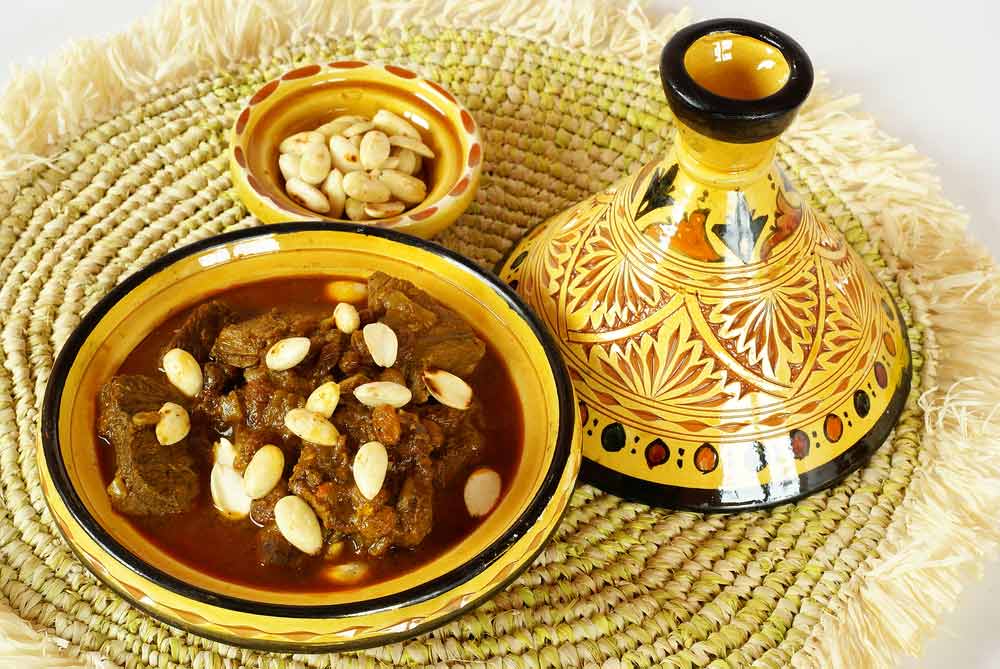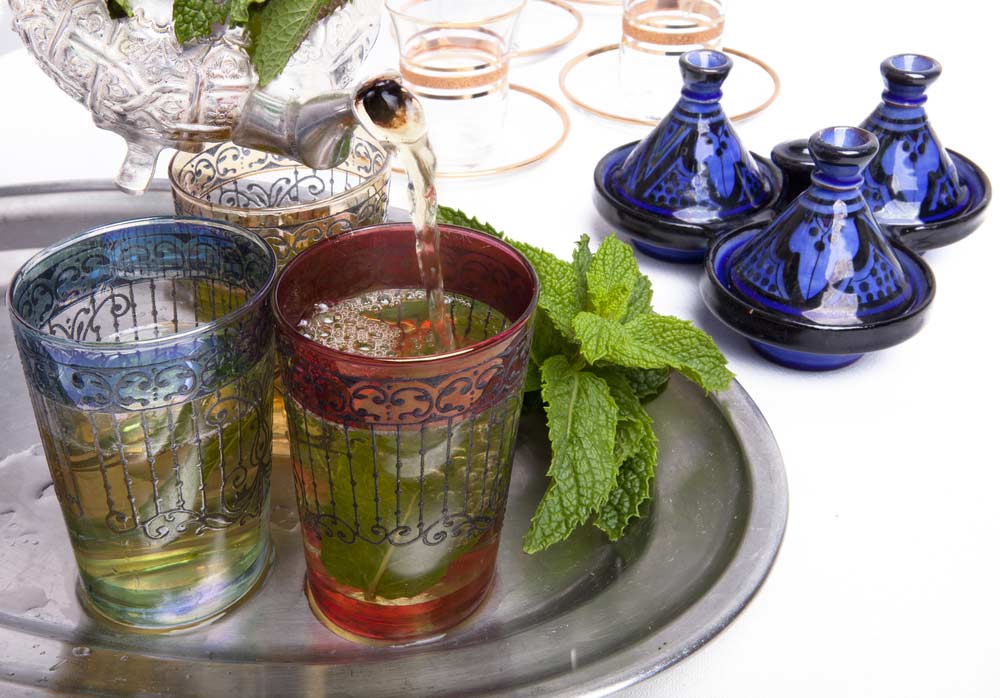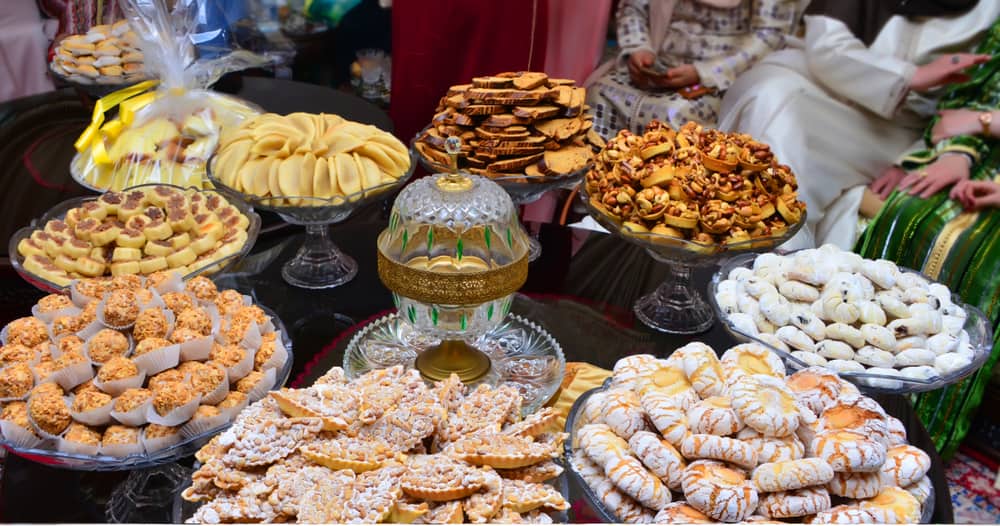Morocco is a country rich in culture and history. One of the best ways to experience this is through its food. Moroccan cuisine is famous for its bold flavors, aromatic spices, and colorful dishes. Each meal is a journey, bringing stories and traditions to life.
Moroccan food reflects its diverse influences. The Berber, Arab, and French cultures have all left their mark. This makes Moroccan cuisine unique and exciting. From bustling street food markets to elegant restaurants, there’s something for everyone.
Eating in Morocco is more than just a meal. It’s an experience that involves all the senses. You’ll see vibrant colors, smell fragrant spices, and taste delicious dishes. Food is an important part of Moroccan culture. Meals are a time for family and friends to gather, share, and enjoy each other’s company.
Traditional Moroccan Dishes
Moroccan cuisine is filled with delicious traditional dishes. These meals are not only tasty but also tell a story of the country’s rich history.

Zaalouk: A Flavorful Eggplant Salad
Zaalouk is a popular Moroccan salad made with eggplant, tomatoes, garlic, and spices. The vegetables are roasted and then mashed together to create a rich, flavorful dip. This dish is often served as a starter or side dish, accompanied by warm bread. The smoky flavor of the roasted eggplant combined with the tangy tomatoes and aromatic spices makes zaalouk a delightful addition to any meal. It is a great example of how Moroccan cuisine can turn simple ingredients into something truly special.
Tagine: The Iconic Moroccan Dish
Tagine is a famous Moroccan dish named after the pot it’s cooked in. This dish is a slow-cooked stew made with meat, vegetables, and lots of spices. The unique pot, with its cone-shaped lid, helps to keep the steam in, making the food tender and full of flavor. You can find tagines made with chicken, beef, lamb, or even fish. Each type of tagine has its special blend of spices like cumin, coriander, and cinnamon. Often, dried fruits such as apricots or prunes are added for a touch of sweetness. Tagine is usually served with warm bread or couscous, which helps soak up the rich sauce. It’s a dish that brings families together, often enjoyed during special occasions and family gatherings.
Couscous: The Staple Food
Couscous is a staple in Moroccan homes. It is made from tiny steamed balls of semolina wheat. This dish is very versatile and can be paired with meat, and vegetables, or even eaten on its own with a bit of butter. One popular way to serve couscous is with a hearty vegetable stew poured over it. This dish is often enjoyed on Fridays, which is a special day for family meals in Morocco. Traditionally, couscous is cooked in a special pot called a couscoussier. This pot has two parts: one for steaming the couscous and one for cooking the stew. This method helps to infuse the couscous with the flavors of the stew. Couscous is more than just food; it’s a symbol of Moroccan hospitality and togetherness.
Pastilla: The Sweet and Savory Pie
Pastilla is a unique Moroccan pie that blends sweet and savory flavors. It is usually made with pigeon or chicken, mixed with almonds, eggs, and a variety of spices like saffron and cinnamon. This filling is then wrapped in thin, crispy pastry layers and baked until golden brown. What makes pastilla special is the topping of powdered sugar and cinnamon, giving it a sweet touch. This dish is often served at weddings and special celebrations, showcasing the richness of Moroccan culinary traditions. The combination of flavors and textures makes pastilla a favorite among both locals and visitors.
Fish Chermoula: Marinated and Grilled to Perfection
Fish chermoula is a delicious Moroccan dish made with fresh fish marinated in a blend of herbs and spices. Chermoula, the marinade, typically includes ingredients like cilantro, parsley, garlic, lemon juice, and a mix of spices such as cumin and paprika. The fish is marinated for several hours to absorb all the flavors, then grilled or baked until perfectly cooked. This dish is often served with a side of steamed vegetables or couscous. The vibrant flavors of the chermoula complement the fish beautifully, making it a must-try for seafood lovers.
Street Food in Morocco
Street food is an exciting part of Moroccan cuisine. It offers a chance to taste many different flavors and dishes.
Popular Street Foods
One of the most popular street foods in Morocco is msemen, a type of flaky pancake. Msemen can be enjoyed plain or stuffed with onions and spices. It’s often served with honey or jam for a sweet treat. Another favorite is sfenj, a deep-fried doughnut. Sfenj is crispy on the outside and soft on the inside, often enjoyed with a cup of mint tea.
Exploring Street Food Markets
Exploring street food markets in cities like Marrakech and Fes is a delightful experience. These markets are filled with stalls selling all kinds of delicious food. You’ll find everything from grilled meats to fresh juices. The sights, sounds, and smells of the market create a vibrant atmosphere. To enjoy street food safely, it’s best to eat at stalls that are busy with locals, as this usually means the food is fresh and tasty.
Drinks and Refreshments
Moroccan drinks are just as exciting as its food. They offer a refreshing complement to the rich flavors of the cuisine.

Moroccan Mint Tea
Moroccan mint tea is more than just a drink; it’s a symbol of hospitality. This tea is made with green tea, fresh mint leaves, and lots of sugar. The tea is poured from a height to create a frothy top, which is part of the tradition. Drinking mint tea is a social activity in Morocco. It’s often served to guests as a sign of welcome and friendship.
Fresh Juices and Smoothies
Fresh juices and smoothies are also popular in Morocco. You can find juice stands in markets and streets, offering a variety of flavors. Orange juice is especially popular, thanks to the abundance of sweet, juicy oranges. Other favorites include avocado smoothies and pomegranate juice. These drinks are not only delicious but also packed with vitamins and nutrients.
Sweet Treats
Moroccan sweets are a delightful part of the culinary experience. They are often enjoyed with tea or as a dessert.

Traditional Moroccan Sweets
Baklava is a famous sweet treat made with layers of thin pastry, nuts, and honey. It’s sticky, sweet, and very satisfying. Chebakia is another popular sweet, especially during Ramadan. These flower-shaped cookies are fried and then dipped in honey, with sesame seeds sprinkled on top. They are chewy, crunchy, and full of flavor.
The Role of Sweets in Moroccan Celebrations
Sweets play a big role in Moroccan celebrations. During weddings and holidays, a variety of sweets are served to guests. This includes almond briouats, which are pastry triangles filled with almond paste and dipped in honey. Sweet treats are a way to show hospitality and share joy during special occasions.
Unique Culinary Experiences
Experiencing Moroccan cuisine goes beyond just eating; it includes cooking and learning about the culture.
Cooking Classes with Local Chefs
Taking a cooking class with a local chef is a great way to learn about Moroccan food. In these classes, you’ll learn to prepare traditional dishes like tagine and couscous. The chef will teach you about the spices and techniques used in Moroccan cooking. It’s a hands-on experience that gives you a deeper appreciation of the food.
Food Tours and Tastings
Food tours are another way to explore Moroccan cuisine. These tours take you to different markets, stalls, and restaurants where you can taste a variety of dishes. You’ll get to try everything from street food to gourmet meals. A knowledgeable guide will explain the history and significance of each dish, making the experience both tasty and educational.
Broader Aspects of Moroccan Cuisine
Moroccan food is influenced by many factors, from history to geography.
Influence of Berber, Arab, and French Cultures
The Berbers were the first to live in Morocco, and their food traditions still influence the cuisine today. Arab influences brought new spices and cooking techniques. French colonization introduced new ingredients and styles, blending with local traditions to create unique dishes.
Regional Variations in Moroccan Food
Different regions in Morocco have their special dishes. For example, coastal areas like Essaouira are known for their seafood. Inland cities like Marrakech have their specialties, such as tanjia, a slow-cooked meat dish. These regional differences add variety and richness to Moroccan cuisine.
Sustainability and Local Sourcing
Moroccan cuisine often uses locally sourced ingredients, which helps support local farmers and markets. Traditional farming methods are still used, which helps preserve the environment. Eating locally sourced food also ensures that the ingredients are fresh and full of flavor.
Conclusion
Moroccan cuisine is a journey of flavors, colors, and traditions. From savory tagines to sweet treats, every dish tells a story. Experiencing Moroccan food is not just about eating; it’s about understanding and appreciating the culture. Whether you’re tasting street food in a bustling market or learning to cook a traditional dish, you’re sure to enjoy the rich culinary heritage of Morocco.
